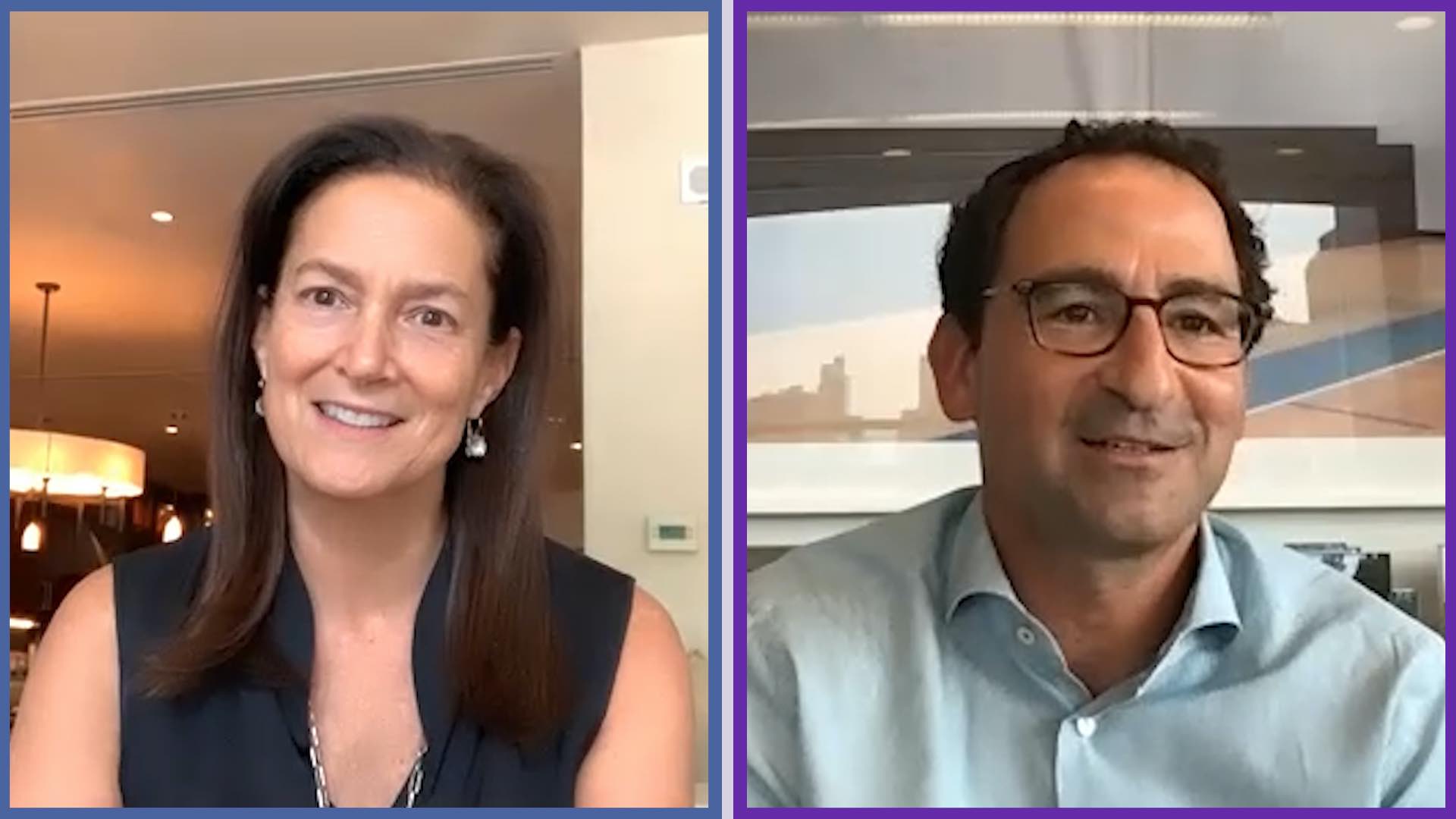| |
| |
| |
| Presented By Goldman Sachs |
| |
| Axios Markets |
| By Dion Rabouin ·Dec 02, 2020 |
| Good morning! Was this email forwarded to you? Sign up here. (Today's Smart Brevity count: 1,179 words, 4½ minutes.) 🎙 "Without craftsmanship, inspiration is a mere reed shaken in the wind." — See who said it and why it matters at the bottom. |
| |
| |
| 1 big thing: Bond investors look to be joining the risk-on party |
 |
|
| Illustration: Sarah Grillo/Axios |
| |
| Long-dated U.S. Treasury yields jumped on Tuesday, as momentum pushed bond investors to sell and join the risk-on party in financial markets. Why it matters: Bond investors have largely been incredulous about the prospects for U.S. growth and inflation — but recent good news on COVID-19 vaccines, global manufacturing data and U.S. holiday retail sales helped push yields on the 10-year Treasury note up by the most in nearly a month. By the numbers: Yields on the 10-year jumped by more than 9 basis points to 0.938%, the highest since Nov. 12, and the spread between 2-year and 10-year yields widened to the largest since Nov. 12. - Yields on the 10-year are now knocking on the door of 1%, a level not seen since March.
- Breakeven rates for 10-year Treasury Inflation Protected Securities (TIPS) reached 1.82%, the highest since May 2019.
What we're hearing: Investors are finally starting to take their money out of safe-haven Treasuries and move consistently into equities and some areas of the market that previously had been deemed too risky, Ellis Phifer, market strategist at Raymond James, tells Axios. - "Europe and EM have been beaten up a lot and that's where the money starts going, where people feel they can put a little risk back out there."
- "It's hard to get too excited but we did see some rotation that is pretty significant into more risky assets from the bond market."
Watch this space: The Institute of International Finance estimates that emerging market securities attracted around $76.5 billion in November, more than triple the $23.5 billion fund flow in October. - "As a result, Q4 2020 is likely to be the strongest quarter for EM inflows since Q1 2013, i.e. since just before the 'taper tantrum,'" IIF economist Jonathan Fortun said in a report.
Don't sleep: More Wall Street analysts are jumping on the bull bandwagon. Barclays released a cadre of late-night notes to clients Tuesday touting their expectations for equity prices to continue higher. - "We remain overweight risk assets over core bonds, as investors look through the near-term drag of the winter COVID surge and focus instead on a resilient global economy and a faster return to normalcy in 2021," Barclays analysts said.
- They project a "drift higher in core fixed income yields, and for emerging markets to do well."
The bottom line: Even with rising COVID-19 diagnoses and continued uncertainty about fiscal stimulus (Senate Majority Leader Mitch McConnell rejected a proposed bipartisan coronavirus stimulus package yesterday), Wall Street looks to be all-in on risk right now. |
    |
| |
| |
| Bonus chart: The wilting dollar |
 Data: FactSet; Chart: Axios Visuals The bid for European and emerging market stocks means investors are pulling funds out of dollars and putting them into other currencies. - That combined with expectations of more monetary policy easing from the Fed and no end in sight to its zero interest rate policy has pushed the dollar to its lowest level since April 2018.
- The dollar index, which tracks the greenback's value against six major global currencies, fell to a 2.5-year low of 91.13 overnight.
- Traders are wagering the slide will continue as net short bets that the dollar will fall in value rose to their highest level since late October, according to CFTC data released on Monday, calculated by Reuters.
Of note: The U.S. dollar fell to its lowest in 2.5 years against the euro and the New Zealand dollar on Tuesday. |
    |
| |
| |
| Double bonus chart: Manufacturing industry confidence stays 💪🏾 |
 Data: Institute for Supply Management, IHS Markit; Chart: Axios Visuals Two surveys of the U.S. manufacturing industry both showed strong readings last month, with data provider IHS Markit's reading touching its highest level since late 2014. Between the lines: The headline numbers were reassuring, as were the report's details. - "The rise in investment spending sends a welcome signal that companies have become more optimistic about longer term prospects, something that was reinforced by a surge in firms' expectations about production in the year ahead — even in consumer-facing sectors — to the highest since early-2015," Chris Williamson, chief business economist at IHS Markit, said in a press release.
The big picture: "If we look at the world's six largest economies they either have buoyant November manufacturing PMIs (US, China, Germany, India and the UK), or, in the case of a lagging Japan, are showing clear signs of improvement," says Deutsche Bank chief international strategist Alan Ruskin in a note to clients titled "Global PMI is in a 'big is beautiful' virtuous cycle." |
    |
| |
| |
| A message from Goldman Sachs |
| Blackstone's Jon Gray on the future of investing |
| |
 |
| |
| Jon Gray joins Goldman Sachs' Insights from Great Investors to discuss the themes driving Blackstone's investment strategy as well as the importance of "high conviction" in his approach to investing. Find out what he had to say on what makes a successful investor. |
| |
| |
| 2. Catch up quick |
| Salesforce announced its plan to acquire Slack in a $27.7 billion stock and cash megadeal. (TechCrunch) Americans spent $10.8 billion on Cyber Monday, making it the largest online shopping day in U.S. history, according to Adobe Analytics data. (CNBC) The 25% tariffs on Chinese imports that were left in place as part of the phase one U.S.-China trade deal will remain at the start of the new administration, President-elect Joe Biden said. (N.Y. Times) President Trump threatened to veto the $740 billion defense spending authorization bill that would keep the government funded unless Congress repeals a federal law that protects social media sites from legal liability. (Twitter) |
    |
| |
| |
| 3. Biden economic team will write a new crisis playbook |
 Data: BLS via FRED; Chart: Andrew Witherspoon/Axios Axios' Felix Salmon and Courtenay Brown write: Biden's economic team faces a daunting task helping the millions of Americans who have lost their jobs or have otherwise been financially ravaged by the coronavirus. - But most of them have first-hand crisis experience, dating back to when Barack Obama inherited a crumbling economy when he took office in 2009.
Why it matters: Most of Biden's economic nominees served in the Obama administration, and wish that they could have gone bigger to help America recover from the 2008 financial crisis. But it's not going to be easy for them to push through massive fiscal spending in 2021. By the numbers: - Employment is much worse than during the Great Recession. The total number of jobs in America is still more than 10 million below its peak, even after a significant rebound.
- The unemployment rate is currently 6.9% — better than the 7.8% that Biden inherited when he took office as vice president in January 2009, and much better than the 9.9% level that it hit later that year. That's partly because millions of jobless Americans, including many parents forced to stay home to help school their kids, aren't counted as unemployed because they're not actively looking for work.
- GDP is about 3.5% below its peak, roughly the same as in the first quarter of 2009.
Flashback: "Anyone who was involved from Treasury, from Fed, in the financial world, will tell you that the U.S. economy needed more of a boost for longer than it got" back then, former Treasury Secretary Jack Lew, who also served as the head of the Office of Management and Budget under Obama, tells Axios. - "If you look through [Biden's] team ... I don't know anyone who doesn't agree with that."
|
    |
| |
| |
| 4. Eyeing the impact of the Fed's guidance |
| Cleveland Fed researchers Wesley Janson and Chengcheng Jia posted a recent study looking at whether the forward guidance provided with the April and June FOMC meetings changed the public's expectations for the economy and monetary policy. "We find that forward guidance was effective in altering the public's expectations about future policy rates if it was accompanied by a Summary of Economic Projections (SEP) but not expectations about economic fundamentals." "The publication of the SEP allowed the public to get more quantitative information about the likely path of future monetary policy in addition to the qualitative information given in the post-meeting statements." |
    |
| |
| |
| A message from Goldman Sachs |
| What's on the minds of some of the world's great investors? |
| |
 |
| |
| Each week, Goldman Sachs brings viewers an interview with leading private and public investors. Why it's important: Some of the world's greatest investors will provide insight on their investing philosophies and how they are approaching the new investing landscape. Explore their insights. |
| |
| Thanks for reading! Quote: "Without craftsmanship, inspiration is a mere reed shaken in the wind." Why it matters: On Dec. 2, 1883, Johannes Brahms premiered his "3rd Symphony in F" with the Vienna Philharmonic Orchestra. |







No comments:
Post a Comment